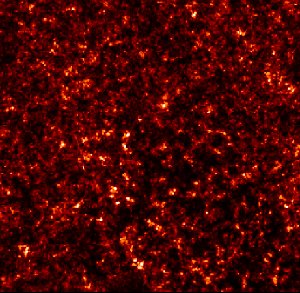|
|  |
The endless space of the Universe is filled with galaxies whose
billion year old light can be observed with our telescopes
today. However, galaxies are not distributed in an arbitrary way. In
fact, galaxies mark the contours of a gigantic cosmic network. This
network, consisting of mysterious invisible dark matter, was formed
throughout cosmic history by the interaction of many physical
phenomena.
The origin of these observed structures are to be found in the
microscopic quantum fluctuations which occurred during the initial
split seconds of the Universe. During the following 14 billion years,
predominantly, gravity formed these initial fluctuations into the
cosmic web observed today.
The exact measurement and mapping of these cosmic structures permits
us to gain insight into the early phases of the Universe shortly after
the big bang, when space was still filled with hot plasma and no stars
or galaxies existed. Furthermore, analyses of this structure will shed
light on the properties of cosmic matter, gravity and galaxy formation
as well as the geometrical properties of space and time of the
Universe. Such cosmic maps additionally permit the prediction of a
variety of observational effects, which can be compared to actual
measurements and used to test our understanding of space, time and
matter.
However, in contrast to sailors and discoverers in the past, who
explored the outlines of the continents with their ships, today we can
map the structures in the Universe only through our telescopes on
Earth. Unfortunately, every observation or measurement of the galaxy
distribution is always subject to a variety of observational
uncertainties. In particular, decreasingly faint galaxies are detected
with increasing distance from Earth. Consequently, with growing
distance, also the information about the cosmic structure disappears
in the fog of uncertainty. Hence, in large distances or poorly
observed regions the cosmic structures appear fuzzy and their contours
can only be estimated.
Therefore, a scientifically useful map of the Universe must, aside
from the description of the cosmic structure, also make statements
regarding their plausibility. Here, the plausibility is quantified -
according to the mathematician Bayes - using a probability, which
expresses to what accuracy one can identify the cosmic web.
The generation of such maps requires sampling of extremely high
dimensional spaces and has been computationally impractical so far.
For this reason, Jens Jasche from the Max Planck Institute for
Astrophysics developed the computer algorithm HADES (HAmiltonian
Density Estimation and Sampling). This algorithm now allows the
analysis and assessment of three dimensional cosmic structures.
HADES provides not only a single map of the Universe, it actually
generates a full set of different maps. On average these maps
represent the same observational data but differ in all other
respects. Each of these maps hence displays a possible Universe, which
is compatible with the observational data. Structures which are
present in all maps are more credible than those which can be found
only in a few maps. This set of maps therefore provides information
about the credibility of all mapped structures, which is essential for
subsequent scientific analyses.
Based on this method, an international researcher team, consisting of
scientists from the Max Planck Institute for Astrophysics in Germany
and the Scuola Normale Superiore di Pisa in Italy, has now determined
the most accurate representation of our cosmic environment from the
Sloan Digital Sky Survey galaxy data. The analysis comprises a cubic
volume of more than 2.1 billion light years and reflects in
astonishing quality the large scale cosmic web. As predicted by
simulations, this web consists of many filamentary structures and
large empty regions.
Overall, the scientists generated about 40,000 of such possible
Universes and yielded three Tera byte of data. This permits them to
judge the credibility of detected structures and to determine precise
confidence limits. The obtained cosmic cartographical material now
allows detailed analyses of galaxy and structure formation and the
prediction of a variety of physical effects, which can be measured and
tested by the Planck Surveyor satellite mission or the LOFAR radio
interferometer.
Future observations of the galaxy distribution will permit far larger
and more detailed cosmic maps. Then the team of scientists at the Max
Planck Institute will stand by to push the limits of the known
Universe further into the depth of space.
Jens Jasche, Franciso S. Kitaura, Cheng Li, Torsten A. Enßlin
Involved Institutions:
Max Planck Institute for Astrophysics, Garching (JJ, CL, TAE)
Scuola Normale Superiore di Pisa (FSK)
Publications
Details on the cosmographic analysis are described in:
J. Jasche, F.S. Kitaura, C. Li, T.A. Enßlin,
"Bayesian non-linear large scale structure inference of the Sloan Digital Sky Survey data release 7",
 arXiv:0911.2498 arXiv:0911.2498
J. Jasche, F.S. Kitaura,
"Fast Hamiltonian sampling for large scale structure inference"
 arXiv:0911.2496 arXiv:0911.2496
|


